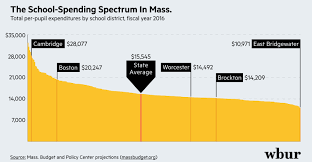The problem at Hand:
Insufficient funding has become a national issue for our public schools. For far too long we as a country have fallen complacent with the current funding systems. These systems put an emphasis on local funding opportunities such as property taxes., which immediately favors the wealthier communities. Cities like Boston, Ma. have failed to remedy this issue in the past and consequently many public schools have struggled to accommodate their communities and staff. Without appropriate funding, schools are unable to provide their students with the resources necessary to facilitate an engaging and effective pedagogy. Without the proper funding, English language learners and students with special needs will not have the proper resources to help them thrive outside or even inside the classroom.
Ever since the mid-1960’s Massachusetts has aimed to resolve the school funding crisis. Comparatively, Massachusetts has become one of the top states in terms of school funding. In 2016 the state was spending $15,593 per student which was well above the national average. To many, this would suggest that additional funding is unnecessary. However, people rarely acknowledge the fact that Massachusetts and Boston especially are very expensive to live in. Boston has become one of the most expensive cities to live in. When costs like that reveal themselves the per-student spending is no longer among one of the best in the nation. Additionally, the per-student spending is only a representation of the major funding disparities that lie within Massachusetts. Around Boston, there are some alarming discrepancies in state funding provided to the counties. Cambridge spends around $28,000 per student while Bridgwater spends around $11,000 per student (Larkin, 2018). These extreme disparities are a product of failing funding formulas and other mismanaged funding policies.
The chapter 70 funding formula was first implemented in 1993 as a part of the Education reform act. It was initially designed to re-allocate state funds to districts with consideration for their need. A district’s Need was determined by analyzing the differences in school budgets and available local funding as well as offering state funding. The funding formula was supposed to take the state money offered to wealthier districts that didn’t need and give it to the poorer “The goal was to help smooth out some of the educational disparities between wealthier communities and poorer ones”(Leblanc, 2018). However, over time the funding formula was manipulated by what some call “political compromises”, and eventually the chapter 70 funding formula lost its purpose and began allocating state funds to wealthier districts while poorer districts still didn’t have enough(Dwyer, 2020). Today, local funding still accounts for the majority of school funding. This confirms the funding formula’s dysfunctionality.
References:
Dwyer, Dialynn. “Report: Mass. School Funding Formula Gives Wealthy Districts More Aid than They Need, Widening Equity Gaps.” Boston.com. The Boston Globe, September 14, 2020. https://www.boston.com/news/education/2020/09/14/massachusetts-business-alliance-education-chamber-of-commerce-school-funding-report.
Larkin, Max. “What You Need To Know About The Failed Education Funding Bills.” What You Need To Know About The Failed Education Funding Bills | Edify, WBUR, 6 Aug. 2018, www.wbur.org/edify/2018/08/03/fact-check-education-funding.
LeBlanc, steve. “Massachusetts Debates 25-Year-Old Education Funding Formula.” Boston.com, The Boston Globe, 15 July 2018, www.boston.com/news/education/2018/07/15/massachusetts-debates-25-year-old-education-funding-formula.
